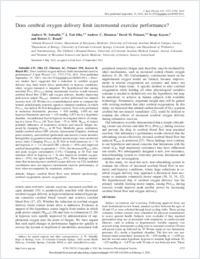Does cerebral oxygen delivery limit incremental exercise performance?
- Subudhi, Andrew W. Department of Biology, University of Colorado Colorado Springs, Colorado Springs; and
- Olin, J. Tod Department of 3Pediatrics and
- Dimmen, Andrew C. Altitude Research Center, Department of Emergency Medicine, University of Colorado Anschutz Medical Campus, Aurora;
- Polaner, David M. Anesthesiology, The Children's Hospital Denver, University of Colorado Anschutz Medical Campus, Aurora, Colorado; and
- Kayser, Bengt Institute of Movement Sciences and Sports Medicine, University of Geneva, Geneva, Switzerland
- Roach, Robert C. Altitude Research Center, Department of Emergency Medicine, University of Colorado Anschutz Medical Campus, Aurora;
Published in:
- Journal of Applied Physiology. - American Physiological Society. - 2011, vol. 111, no. 6, p. 1727-1734
English
Previous studies have suggested that a reduction in cerebral oxygen delivery may limit motor drive, particularly in hypoxic conditions, where oxygen transport is impaired. We hypothesized that raising end-tidal Pco2 (PetCO2 ) during incremental exercise would increase cerebral blood flow (CBF) and oxygen delivery, thereby improving peak power output (Wpeak ). Amateur cyclists performed two ramped exercise tests (25 W/min) in a counterbalanced order to compare the normal, poikilocapnic response against a clamped condition, in which PetCO2 was held at 50 Torr throughout exercise. Tests were performed in normoxia (barometric pressure = 630 mmHg, 1,650 m) and hypoxia (barometric pressure = 425 mmHg, 4,875 m) in a hypobaric chamber. An additional trial in hypoxia investigated effects of clamping at a lower PetCO2 (40 Torr) from ∼75 to 100% Wpeak to reduce potential influences of respiratory acidosis and muscle fatigue imposed by clamping PetCO2 at 50 Torr. Metabolic gases, ventilation, middle cerebral artery CBF velocity (transcranial Doppler), forehead pulse oximetry, and cerebral (prefrontal) and muscle (vastus lateralis) hemoglobin oxygenation (near infrared spectroscopy) were monitored across trials. Clamping PetCO2 at 50 Torr in both normoxia ( n = 9) and hypoxia ( n = 11) elevated CBF velocity (∼40%) and improved cerebral hemoglobin oxygenation (∼15%), but decreased Wpeak (6%) and peak oxygen consumption (11%). Clamping at 40 Torr near maximal effort in hypoxia ( n = 6) also improved cerebral oxygenation (∼15%), but again limited Wpeak (5%). These findings demonstrate that increasing mass cerebral oxygen delivery via CO2 -mediated vasodilation does not improve incremental exercise performance, at least when accompanied by respiratory acidosis.
- Language
-
- English
- Open access status
- green
- Identifiers
-
- DOI 10.1152/japplphysiol.00569.2011
- ISSN 8750-7587
- Persistent URL
- https://sonar.ch/global/documents/23280
Statistics
Document views: 3
File downloads:
- fulltext.pdf: 0
